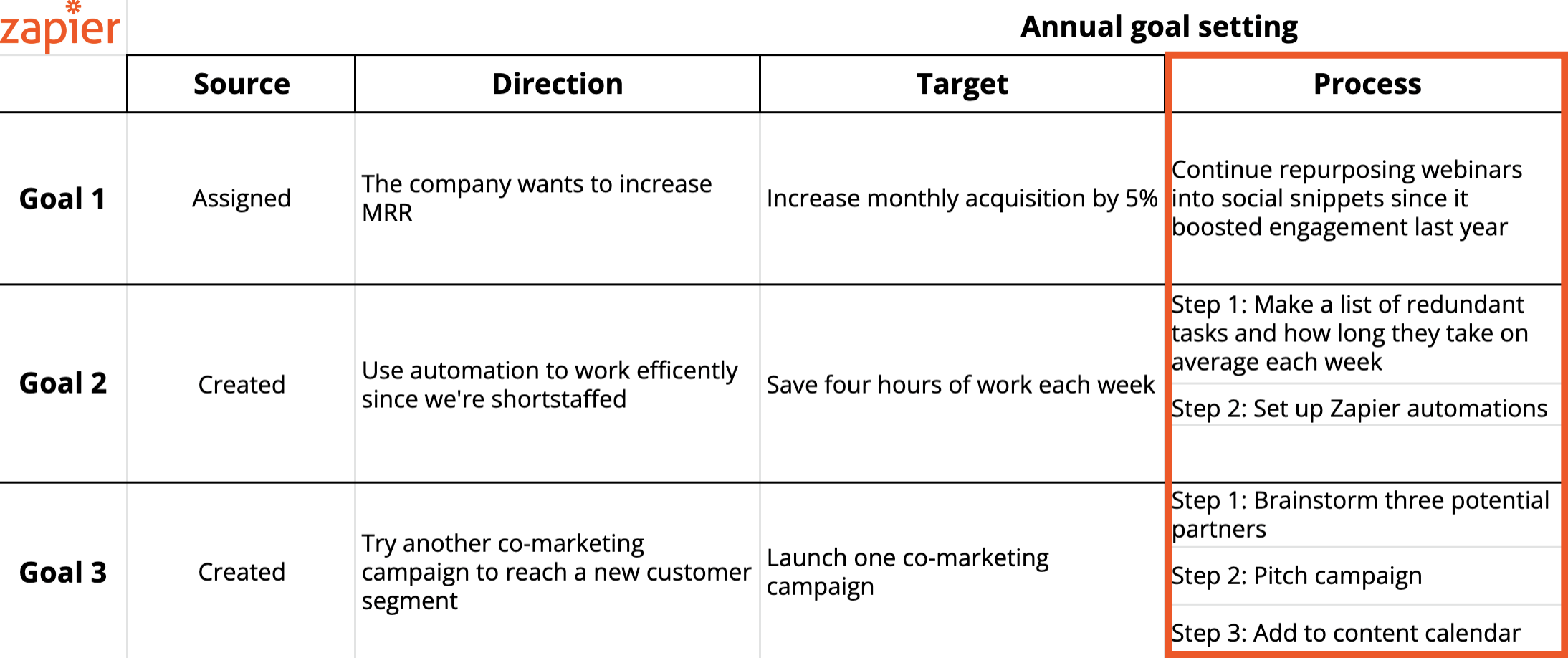After the shock of another year passing wears off and the dust of your annual review settles, you have to make some choices. Sometimes, a seemingly endless sea of choices.
Ambitious teams and individuals can easily bite off more than they can chew during year-end goal-setting sessions as the golden light of possibilities shines down. So as with your year-end review, it's all about being organized and straightforward. No rabbit holes allowed.
How to set work goals that set you up for success
Goals are very Goldilocks in nature. Too vague, and you'll struggle to know when you've hit the mark. Too specific, and you could feel restricted or frustrated if you don't follow the plan to a T. The just right mix comes from setting a goal and a process.
Make a copy of this goal-setting template, and then follow along for instructions on how to fill it out. Each section includes an example (based on a marketing team), which you can also see on the second sheet of the template.
1. Understand the source
Goals come in all shapes, sizes, and sources. Before you can begin to make sense of your objectives, it helps to think about where they're coming from. The source of the goal may sway its priority and who the stakeholders are.
Your goals are likely to either be assigned or created.
Assigned goals are derivative of a bigger movement, such as a company-wide goal.
Example: Your company wants to increase monthly recurring revenue (MRR) this year. The marketing team will want to increase acquisition, the UX research and product teams will aim to improve retention, and the customer success team will work to upsell users.
Created goals form when you add clarity to a direction or tactic you want to try.
Example: Your team feels time-crunched, and you know you need to work more efficiently this year. You'd like to incorporate automation, so you set parameters to help you stick to it.
2. Choose a direction
The first step of setting a goal for the new year is establishing a direction. Think of this as a vague summary of what you want to do. Consider the source of the goal and why it matters. If you have a list of ideas lying around anywhere, now's the time to grab it.

3. Set a target
Once you know your direction, you need to set a target. Establish what success means and how you'll know when you've made it. Include which metrics you'll use and how you'll measure progress.

4. Establish a process
You only hit a goal once, so if you only focus on the end, the day-to-day can be discouraging. Outlining what steps and routines you'll use to hit the target gives you a way to ensure you're staying on track. You may use multiple processes or strategies to hit a single goal, so you can split your section up here. If you had processes that worked last year, great—repeat them. If not, make a change.

5. Add a timeline
Adding an end date, or at least a project period, helps you prioritize your work. It can also help you check whether you're being a bit too ambitious. Since you can't accomplish everything in the first month of the year, you'll need to look at everything from a high level to plan accordingly.

You should also take note if your work is contingent on anyone or anything else. You can add an extra column for dependencies if there are a lot, but if your work is less cross-functional, you can drop that in the timeline section.
6. Bring it all together with a summary
Communicating your goals to your team or manager is easier when they're summarized. Pull the details into a single sentence so everyone can get on the same page. These goal statements are also nice to keep somewhere you frequently look, like right above your desk.

Balance your work and goals next year
Goals help guide your work, but remember not to get too caught up in them. The best way to hit your goals is to review them regularly, alter them if needed, and be sure you have the processes in place to make them happen.









